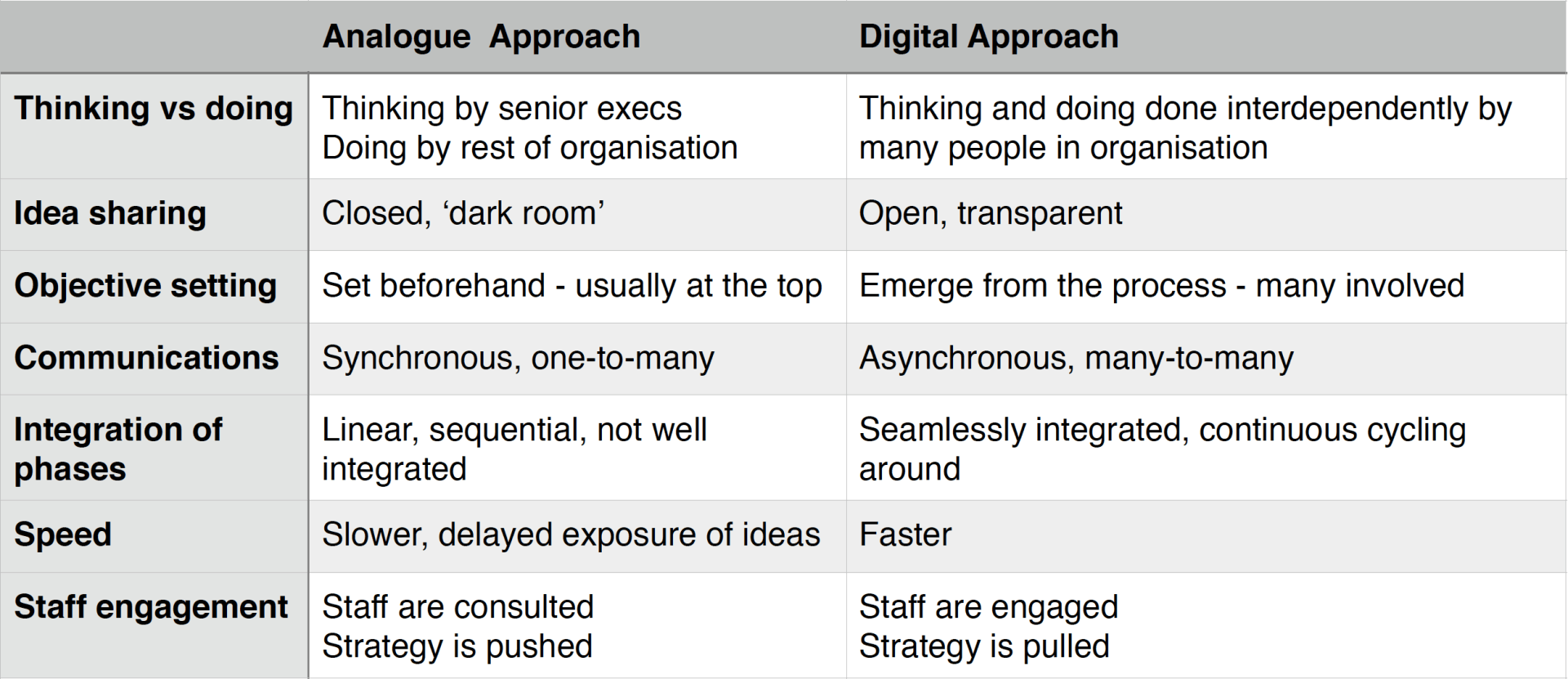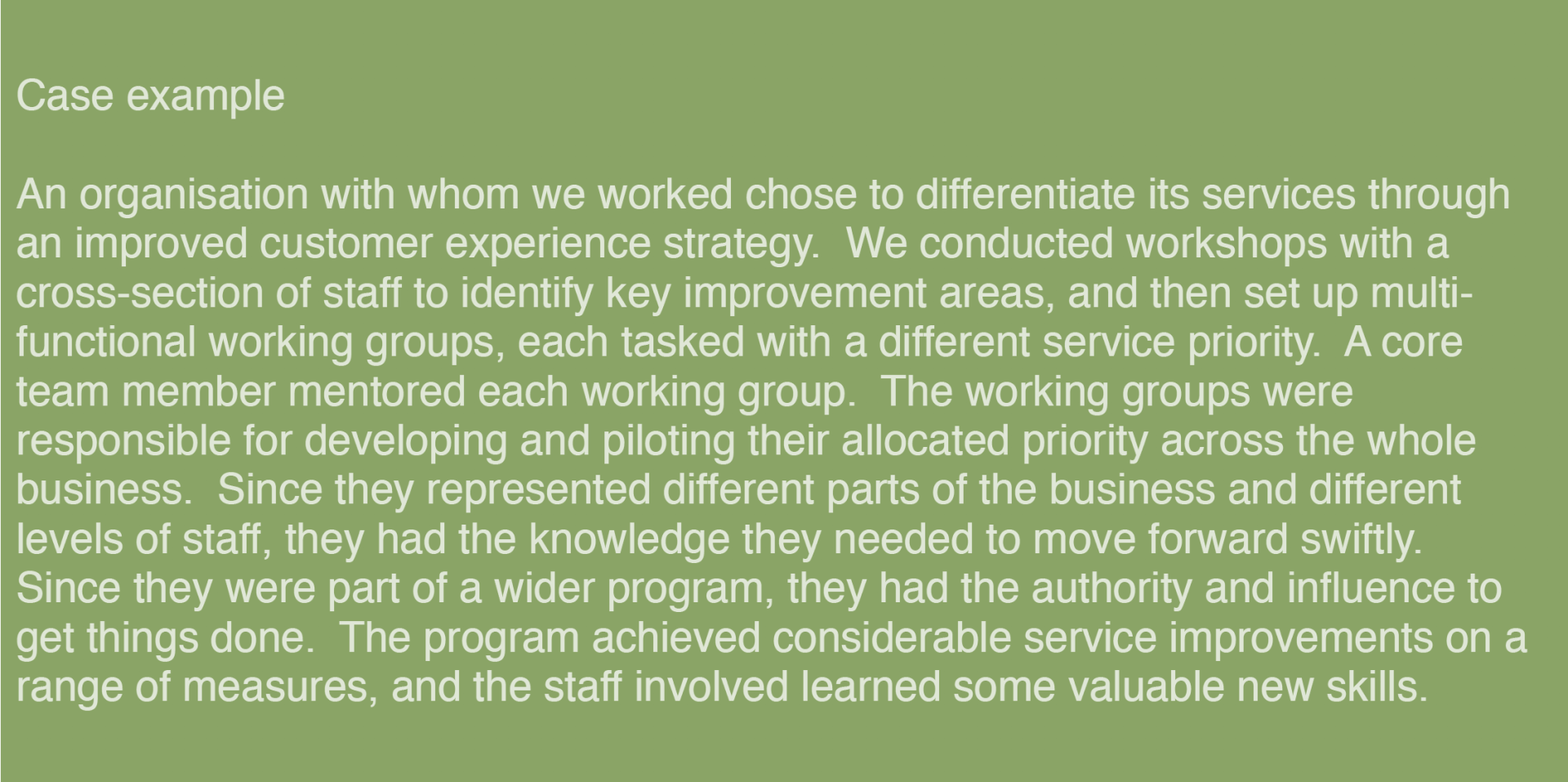A digital approach to strategy.
STRATEGY IS FAILING
Well, to be precise, it is the way we practice strategy that is failing. Research on strategy success and failure suggests that strategic initiatives fail 50-80% of the time. While the reasons for failures are varied and include a flawed proposition or a fundamental misunderstanding of customer needs, leaders are often heard to complain that they simply cannot get their people and organisation to do what they want done. Leaders add that there is insufficient innovation in their organisations and consultants report low staff engagement as a key factor in this poor performance. As a consequence, it has become popular to claim that strategy formulation is unimportant - and that the real leverage lies in the execution of the strategy. We argue that this is not a helpful distinction to make, and that it does not lead to an appropriate course of action to address the high failure rate of strategy.
SO, WHY IS STRATEGY FAILING?
As mentioned above, there are many valid reasons for strategy failure, and we don’t intend to address them all. Instead, we want to focus on some specific aspects related to the way that strategy is practiced, and the distinction often made between ‘formulation’ and ‘execution’.
The traditional approach to strategy formulation is to spend weeks and even months analysing information, often with the help of consultants. Consultation internally is typically limited to data collection by means of interviews and focus groups with staff. A wide array of information is analysed by the strategy team, including data gathered from stakeholder interviews internally and externally. This is followed by recommendations to the CEO, executive team and Board. And little, if any information, is exposed to the rest of the organisation until ratified at the top. Execution only begins once recommendations are ratified, often with a delayed start, in a separate phase by a different team.
We refer to this approach as the ‘dark-room’ approach to strategy. The obvious analogy is with old-fashioned photography, where there is a long pause between taking the picture and finally exposing the photograph to the light of day. This is symptomatic of the outdated view that strategy formulation is separate to strategy execution, and that the former should be the domain of a few people in designated ‘leadership’ positions.
So, why should this approach to the practice of strategy be associated with such high failure rates? Research suggests that failed strategy is generally 3 associated with:
An incomplete diagnosis of the situation: This occurs where the information gathering and analysis fails to account for the diversity of views and expertise that exist in a complex organisation. In fast-moving and uncertain environments, it is inconceivable that a few carefully selected people, no matter how skilled and talented they are, can capture the richness of information necessary to understand complex situations.
An incoherent picture of the strategy: By failing to involve a wider number of staff in the diagnosis of the situation, the all important rationale (“why”) behind strategy can get lost. Leaders are then obliged to try and “sell” the strategy to the rest of the organisation (after the recommendations are endorsed) through all the noise, uncertainty and angst created by the new strategy. This is usually associated with high levels of misunderstanding and cynicism. This, in turn, leads to fear and resistance through the organisation.
Low staff engagement with the organisation and strategy Our new understanding of the human brain4 suggests that some of its major goals are social inclusion and perceptions of status and fairness. Our brains will react negatively to situations where any of these are threatened - without us even being aware of it. The consequences are significant for human productivity and innovation. In general, it results in a transactional relationship to the organisation
(the ‘9 - 5’ mentality) and a disengagement from the goals and aspirations of the organisation.
Alarmingly, this negative impact is heightened amongst knowledge workers - leaders are likely to get only grudging acceptance when they announce a new strategic direction after emerging from the “dark room”. As a result of these reactions during the analogue process of “dark room” strategy, it is no wonder that leaders complain about not getting their strategy implemented. What, then, does a digital approach to strategy involve? And how might this offer the promise of
improved strategy execution? The two approaches are compared in the following table:
A DIGITAL APPROACH TO STRATEGY
By digital approach, we are not referring to a web-based strategy per se (although web is likely to feature in any strategy nowadays). We characterise a digital approach to strategy as having 3 elements: open strategy, many-to-many synchronous communication, and seamless integration between strategy formulation and execution.
An open strategy development process immerses a representative cross-section of people within the organisation. This is opposite to the traditional “dark room” approach, where the strategy is only communicated widely only after it has been endorsed by the Board.
A many-to-many, synchronous communication approach occurs between those responsible for developing the strategy, and the rest of the organisation. Old fashioned analogue approaches are asynchronous, one-to-many communications such as a business analyst conducting data gathering interviews, or a facilitator conducting staff focus groups at periodic intervals to gather intelligence. Those responsible for developing the strategy then disappear for weeks or months back into their “dark room” to assimilate the information they have collected, and develop recommendations. In contrast, a synchronous communications approach is not periodic; it is an ongoing working methodology with staff at different levels, who are participating in various working groups, working concurrently on developing and implementing different ideas, with coordination by a core project team in a many-to many relationship. This is a crowd-sourced approach.
A seamless integration between strategy formulation and execution phases is noticeable through iterative stages - pilots - with built-in learning and feedback processes. Ideas are trialled through small-scale, low-risk pilots, which means some execution of ideas is happening concurrently with formulation of other ideas. This removes the artificial divide between formulation and execution phases, and again speeds up execution. The strategy development and execution architecture needs to be carefully designed to take these 3 elements into account, and it is likely to include a number of working groups involving a significant proportion of representative staff, with a small, core project team.
This may sound like it is merely an approach of extensive staff consultation. This is not staff consultation, but rather it is co-opting and engaging staff with the strategy development and execution process. In a digital approach, staff are invited to join working groups with carefully architected responsibilities, that contribute in a meaningful way to the strategy development and execution. They have a shared responsibility with the core project team for generating a work product and outcome. This means the core project team are relinquishing some of their control of the outcome to the working groups, but still mentoring and guiding the teams through their work. This enables the core team to
leverage their efforts considerably, and get accelerated results.
BENEFITS AND CAVEATS OF A DIGITAL APPROACH
By moving out of the dark room to a digital approach, organisations can be more nimble and flexible, enabling faster responses to market conditions. In the same way as digital cameras have sped up the process of producing a photo, digital strategy enables ideas to be executed much faster. With a digital approach to strategy, staff participating in the strategy formulation process are already modifying their work to fit with the new direction. It creates a tide of enthusiasm, a ‘buzz’ that generates a critical mass in the organisation without management needing to ‘sell’ the new direction. It is a pull rather than a push approach.
Different perspectives can be tapped throughout the organisation, which generates better quality data and decision making in a world of uncertainty, with an abundance of information, and a diversity of views. The caveat for a digital approach is to consider carefully how to approach highly sensitive information. Strategy may be highly market sensitive, for example exploring a merger with a competitor, or sensitive for staff, where jobs may be at stake. This will make a digital approach challenging, and each strategy initiative will need to be carefully orchestrated with an appropriate execution architecture. However it is worthwhile bearing in mind that in our digital era, even the most sensitive information can no longer be assured of protection by the world’s most sophisticated security. Wikileaks is a probably the most high profile example. This may cause executives to re-consider their approach to handling such sensitive information, and how a digital approach can be modified to suit such situations.
Subscribe to our regular articles, insights and thought leadership






